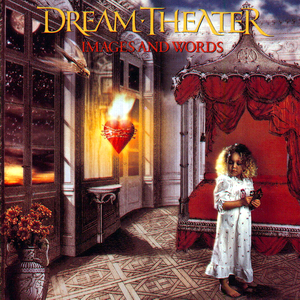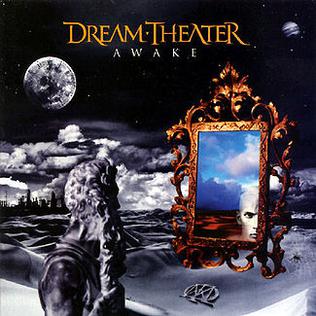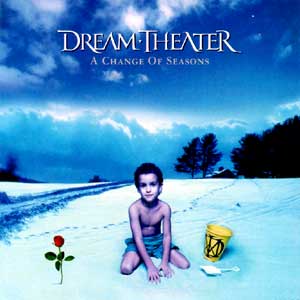
Dream Theater is an American progressive metal band formed in 1985 under the name Majesty by John Petrucci, John Myung and Mike Portnoy — all natives of Long Island, New York — while they attended Berklee College of Music in Boston, Massachusetts. They subsequently dropped out of their studies to concentrate further on the band that would eventually become Dream Theater. Their current lineup consists of Petrucci, Myung, vocalist James LaBrie, keyboardist Jordan Rudess and drummer Mike Mangini.

Metropolis Pt. 2: Scenes from a Memory is the fifth studio album and first concept album by American progressive metal band Dream Theater, released on October 26, 1999, through Elektra Records. It was recorded at BearTracks Studios in Suffern, New York, where the band had previously recorded their second studio album, Images and Words (1992), and the EP A Change of Seasons (1995).

Images and Words is the second studio album by American progressive metal band Dream Theater, released on July 7, 1992, through Atco Records. It is the first Dream Theater release to feature James LaBrie on vocals. Since its release, the album has maintained its position as the band's most commercially successful studio album, and the song "Pull Me Under" has the distinction of being the only Top 10 hit the band has had to date. This particular song has also had more recent success as it has appeared in the 2008 video game Guitar Hero World Tour.

Train of Thought is the seventh studio album by American progressive metal band Dream Theater, released on November 11, 2003 through Elektra Records.

John Peter Petrucci is an American guitarist, best known as a founding member of the progressive metal band Dream Theater. He produced or co-produced all of Dream Theater's albums from Metropolis Pt. 2: Scenes from a Memory (1999) to A View from the Top of the World (2021), and has been the sole producer of the band's albums released since A Dramatic Turn of Events (2011). Petrucci has also released two solo albums: Suspended Animation (2005) and Terminal Velocity (2020).

Awake is the third studio album by American progressive metal band Dream Theater, released on October 4, 1994, through East West Records. It is the final Dream Theater album to feature original keyboardist Kevin Moore, who announced his decision to leave the band during the mixing process of the album.

A Change of Seasons is the first EP by American progressive metal band Dream Theater, first released on September 19, 1995, through East West Records. It comprises the 23-minute title track and a collection of live cover songs performed at a fan club concert on January 31, 1995, at Ronnie Scott's Jazz Club in London.

Falling into Infinity is the fourth studio album by American progressive metal band Dream Theater, released on September 23, 1997, through EastWest Records. It is the band's only studio album to feature keyboardist Derek Sherinian, following the departure of Kevin Moore in 1994.

Six Degrees of Inner Turbulence is the sixth studio album by American progressive metal band Dream Theater, released as a double-disc album on January 29, 2002, through Elektra Records. Excluding the A Change of Seasons EP, it is the first Dream Theater album to feature a title track. It is also their second longest studio album to date, after The Astonishing (2016). All songs from it have been played live.

Once in a LIVEtime is the second live album by American progressive metal band Dream Theater, released in 1998. It is their second live release. It was produced and recorded by Kevin Shirley during the European leg of the Touring into Infinity world tour, at the Bataclan theater in Paris.
"Another Day" is a song by American progressive metal band Dream Theater, released in their 1992 album Images and Words. It was released as the album's second and final single in 1993.
"Six Degrees of Inner Turbulence" is the sixth song and title track on the album of the same name, written and performed by progressive metal/rock band Dream Theater. Though the song is essentially broken up into eight movements on separate tracks, it lasts 42 minutes in full and takes up the entire second CD of the album. The song was conceived when keyboardist Jordan Rudess wrote what would become the "Overture" section, and the band took various melodies and ideas contained within it and expanded them into segments of the complete piece. The song explores the stories of six individuals suffering from various mental illnesses. Particularly represented are bipolar disorder, post-traumatic stress disorder, schizophrenia, post-partum depression, autism, and dissociative identity disorder.

Systematic Chaos is the ninth studio album by American progressive metal band Dream Theater. Released on June 4, 2007 in the United Kingdom and June 5, 2007 in the United States, Systematic Chaos was the band's first release through Roadrunner Records, which was sold to their previous label Atlantic Records, through which the band had released their previous studio album Octavarium (2005). The album was recorded from September 2006 to February 2007 at Avatar Studios in New York City, after the band's first break from summer touring in ten years. The lyrics of the album were written by John Petrucci, James LaBrie, and Mike Portnoy about fictional, political, and personal topics, respectively.
"Octavarium" is a song by American progressive metal band Dream Theater, from the album of the same name.
The Twelve-step Suite is a set of five songs by American progressive metal band Dream Theater. One song was featured on each Dream Theater studio album from Six Degrees of Inner Turbulence to Black Clouds & Silver Linings.
"Space-Dye Vest" is the eleventh and final song from American progressive metal band Dream Theater's 1994 album, Awake. The song was written entirely by the keyboardist Kevin Moore, and its demo featured Moore on vocals. It is structured around a dark, brooding duet between Moore playing the piano and vocalist James LaBrie. The rest of the band kick in for a dramatic outro, fading out until Moore ends the song with the piano passage that opened the song. The song is interspersed with samples from A Room with a View, The Fifth Estate, Late Night with Conan O'Brien, The Trouble With Evan and a news commentary by Jim Hill during the O. J. Simpson freeway chase.

Wither is a single by American progressive metal band Dream Theater, released on September 15, 2009. The single contains the album version of the song "Wither", an alternative version of "Wither" with vocals and piano only, a demo of "Wither" with John Petrucci on vocals, and a demo of "The Best of Times" with Mike Portnoy on vocals. It is the band's last official release with Portnoy, who left the band in September 2010. This is the only studio release without the Majesty symbol in its front cover.

A Dramatic Turn of Events is the eleventh studio album by American progressive metal band Dream Theater, released worldwide in September 2011 through Roadrunner Records. It is the band's first recording to feature drummer Mike Mangini, following the departure of founding member Mike Portnoy in September 2010. The album was written, recorded, mixed, and mastered between January and June 2011 at Cove City Sound Studios in Long Island, New York. It was produced by guitarist John Petrucci and mixed by Andy Wallace. Two singles, "On the Backs of Angels" and "Build Me Up, Break Me Down", were released in promotion of the album.

"Metropolis—Part I: 'The Miracle and the Sleeper'" is a song by American progressive metal band Dream Theater, from their 1992 album Images and Words.

Distant Memories – Live in London is the ninth live album and video by progressive metal band Dream Theater. Recorded on February 21 and 22, 2020, at the Hammersmith Eventim Apollo Theatre during their Distance over Time Tour, the setlist consists primarily of songs from the bands then current album Distance over Time in the first half, followed by a complete performance of the 1999 album Metropolis Pt. 2: Scenes from a Memory, celebrating its 20th anniversary. This marks the second full performance of this record captured on a live album, following 2001's Live Scenes from New York.















